The time-tested and beloved by many summer residents tomato "Dubrava": what is good and why is it worth growing
Many tomato lovers, when choosing a crop for cultivation on their site, are guided by such characteristics as unpretentiousness and high yield. They need a culture for the lazy that can grow and develop on their own.
Based on the description of Dubrava tomatoes, we can say with confidence that this is just such a variety. It is widely known and does not lose its relevance among gardeners. And the secret of popularity lies in the simplicity of care and survival in any weather conditions: in heat or cold, in rain or drought, a tomato equally pleases with a good harvest. Consider the characteristics and description of the Dubrava tomato variety, yield indicators and growing rules.
The content of the article
Description of the variety
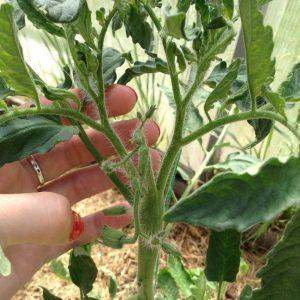 The old tomato variety Dubrava fell in love with farmers for its high yield and resistance to adverse weather conditions. He is well known to both experienced and novice gardeners. Previously, the Dubrava variety was called Dubok, and many, from old memory, call it that now. Dubok has established itself well in Russia and is in stable demand to this day.
The old tomato variety Dubrava fell in love with farmers for its high yield and resistance to adverse weather conditions. He is well known to both experienced and novice gardeners. Previously, the Dubrava variety was called Dubok, and many, from old memory, call it that now. Dubok has established itself well in Russia and is in stable demand to this day.
This is a short, compact plant, the stem height of which reaches no more than 70 cm. The culture takes up little space and is suitable for growing in small summer cottages and even on a balcony.
Refers to determinant... Bushes are strong, slightly branched, but, nevertheless, the leaves completely cover the stem. The leaves are small, light green, corrugated. The inflorescences are simple, medium in size. The first ovary is formed under the 6th leaf, the subsequent ones alternate every two leaves.
The variety is early maturing. The first vegetables turn red 85-90 days after germination. This indicator is typical for the southern regions. In the northern part of our country, ripening occurs only on day 110. The plant is not afraid of cold weather, bears fruit until late autumn.
Since the variety is early maturing, the probability of damage late blight small. But in general, the culture does not differ in resistance to various diseases, so the bushes need regular treatment for preventive purposes.
The fruits are fleshy, round, weighing up to 110 g. The peel is red, compacted, due to which the vegetables are stored for a long time and withstand long-term transportation. Plucked unripe fruits ripen well on their own. There are 5 seed chambers, but there are few seeds in them.
The taste of ripe vegetables is sour, so Oak does not suit everyone. It was originally intended for pickling, but soon it was used for the preparation of tomato products.
The high fertility of low-growing bushes provides up to 5 kg per 1 sq. m. Tomatoes develop well in rainy warm weather with rare sunny days, but the crop will not die in drought, only its yield will decrease. The fruiting period is extended, the fruits are tied before the beginning of September.
How to grow seedlings
Before sowing, the seeds are treated with a disinfectant, for example, a 2% manganese solution. Any container is suitable, but it is preferable to choose plastic dishes. Drainage holes are required at the bottom, since excess moisture will have a detrimental effect on the sprouts. There are no special requirements for the soil, but it will not be superfluous to recall that, like seeds, the soil must be disinfected. This can be done with boiling water. After sowing the seeds, cover the container with foil until the first shoots appear.
Reference. The species does not belong to hybrids, which means that the seeds from the fruits can be used for planting.
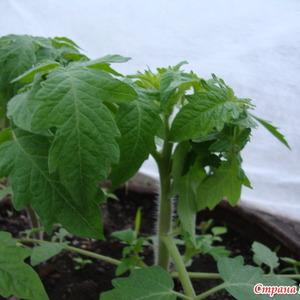 The climatic features of the region affect the timing of sowing seeds. Usually seeds are sown 60 days before planting in the ground. This means that the optimal time for sowing is mid or late March.
The climatic features of the region affect the timing of sowing seeds. Usually seeds are sown 60 days before planting in the ground. This means that the optimal time for sowing is mid or late March.
While the seedlings are in the house, it is necessary to monitor the soil moisture. Drying it out is unacceptable, but the accumulation of moisture is not useful for the first shoots.
When the first pair of leaves appears on young bushes, a pick is carried out. At this moment, the first portion of fertilizers is applied - a complex of mineral components. The second feeding is carried out before planting in open ground, also with minerals.
After 1.5 months, young plants are subjected to hardening, which consists in changing the temperature regime: during the day to maintain at around 18 ° C, and at night to reduce to 12 ° C.
Council.In the northern regions, any lamps that give daylight are used to increase the length of daylight hours.
How to grow tomatoes
Before planting seedlings in the ground, the land on the site must be dug up and all weeds with roots must be removed. Be sure to add organic and mineral fertilizers. Seedlings are planted on the beds when the earth warms up to a depth of 15 cm.
For tomato, both sandy and loamy soil are suitable, into which nitrogen and potash fertilizers are applied in spring. Crop rotation rules will help you choose the right plot for tomatoes: it is recommended to plant them in the beds where zucchini, onions, cucumbers, carrots, cabbage, greens used to grow. The place where representatives of the nightshade family previously grew is not suitable.
Hardened seedlings are transplanted into the ground at 3-4 bushes per 1 sq. m. Loose, weed and huddle every 2 weeks. For the first time after transplanting, it is recommended to protect the plant from sunlight, for example, with burdock leaves. Water the culture at the root and as needed.
Council. If possible, protect the tomato area from wind and draft.
Compliance with the following rules for planting tomatoes in the ground will help young plants to quickly take up in outdoor conditions, which will ensure successful further growth and development:
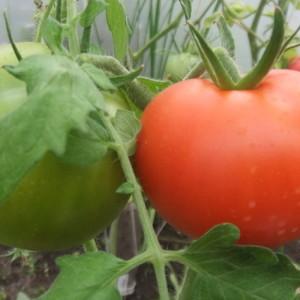 Pour the previously made holes with a manganese solution to disinfect the soil and further protect the fruits from infections.
Pour the previously made holes with a manganese solution to disinfect the soil and further protect the fruits from infections.- Plant the crop so that the first pair of leaves is 2-3 cm above the ground. This will allow the root system to grow, receiving the required amount of fertilizer and oxygen.
- The first 8-10 days, the seedlings do not need watering.
- If necessary, shade the seedlings from the scorching sun.
- Start the formation of bushes only when new leaves appear, breaking off excess shoots and leaving 2 or 3 stems. This has a good effect on the fruiting of the culture.
If you want to get a harvest earlier, the bushes are stepson and the plant is formed into one stem. When forming a bush in 2 stems, the stepsons are removed from the three lower sinuses, when forming in 3 stems - from the two lower ones.
Reference! The formation of bushes in 3 stems leads to higher yields.
A prerequisite at the time of pollination is to maintain the temperature no higher than 25 ° C, otherwise pollination will not occur. Vigilance is necessary from early to mid-May. Use film covers under adverse conditions.
The culture does not need a garter, since the variety is undersized. But tied bushes have their advantages, the main one of which is that vegetables do not touch the ground and do not suffer from rot. At the same time, the integrity of the bush is not violated: it does not break from its own weight.
When breeding low-growing tomatoes, nitrogen-containing fertilizers are applied 1 time during the formation of fruits. Phosphorus and potassium are needed by the culture throughout the growing season. Feeding them is carried out 1 time in 2 weeks.
Diseases and pests
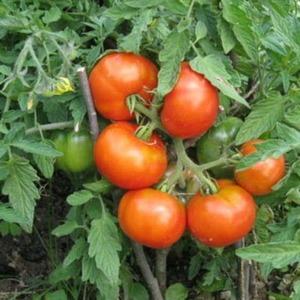 The average resistance of the plant to diseases indicates the need for regular preventive measures.These include chemical treatments, mulching, drip irrigation. For prevention use fungicides of systemic contact action: "Ditan M-45", "Quadris 250". The frequency of prophylactic treatment is once every 20 days.
The average resistance of the plant to diseases indicates the need for regular preventive measures.These include chemical treatments, mulching, drip irrigation. For prevention use fungicides of systemic contact action: "Ditan M-45", "Quadris 250". The frequency of prophylactic treatment is once every 20 days.
When a culture is damaged by late blight, both chemical and folk methods can be used to save the plant. The chemical treatment is Furacilin, and the folk treatment is soda or vinegar. Furacilin solution is prepared simply: 10 tablets in 10 liters of water. Spray until flowers appear, at the first ovaries, at the first fruits. Spray a soda solution every week by dissolving 1 tablespoon of baking soda in half a bucket of water.
Mulching and odorous grasses save from insects living underground. Main land pest Is a bear. Moving underground, it damages the root system, as a result of which the seedlings die. Chopped cloves of garlic and fish heads are also well saved from the bear if they are buried in the beds.
Insecticide treatment 1 month before fruiting will save the plant from tomato mites. Among other things, in order to prevent it, it is necessary to regularly inspect the bushes for the presence of pests from the world of insects.
If the tomatoes are planted in a greenhouse, do not forget about regular airing.
The nuances of growing in open ground and in a greenhouse
Tomato Dubrava is declared as a variety for open ground. When grown in greenhouse conditions, the height of the bushes exceeds 70 cm. And if tomatoes on the street do not need a garter, then you cannot do without it in a greenhouse. Also, the size of the fruit doubles. In the greenhouse, Dubok is more susceptible to disease-causing attacks of fungal infections than anywhere else.
Harvesting and application of the crop
Ripe vegetables are harvested in June. It is not necessary to wait for full ripening, brown tomatoes ripen on their own. The harvested fruits are stored for a long time and are perfectly transported. The main thing is to have time to collect vegetables on time, they crack from overripe.
Due to their sour taste, tomatoes are good in pickles, marinades, conservation... Perfect for making lecho, ketchup, juices, mashed potatoes. But using them fresh is less attractive.
Advantages and disadvantages
The main advantage of the variety is a high quantitative indicator with simple care. But there are still many positive qualities worthy of attention:
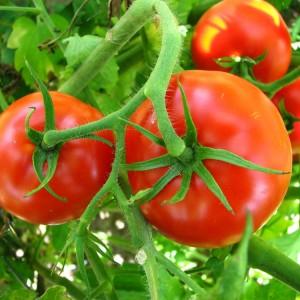 the survival rate of culture in both the southern and northern regions;
the survival rate of culture in both the southern and northern regions;- early ripening;
- does not require pinning;
- does not require a garter;
- the possibility of growing without a greenhouse;
- long storage;
- good transportability;
- the possibility of breeding at home: on the balcony or windowsill;
- ovary formation even in rainy weather;
- crop survival in drought.
The negative aspects of this variety include:
- sour taste of fruits;
- medium resistance to late blight and fungal infections;
- ripening cracking.
Farmers reviews
Reviews of ripe vegetables are very controversial, primarily because of the unusual taste of the fruit. Nevertheless, thanks to the many positive characteristics, they managed to win a lot of fans.
There are cases when Dubok, when creating the necessary conditions, developed well on the windowsill, delighting with red fresh vegetables for the New Year. Farmers especially emphasize the minimum expenditure of effort in comparison with the final quantitative result. And of course, the early ripeness of tomatoes captivates, which makes it possible to feast on them from the first summer month.
Elena, Volgograd:“I didn't like the oak. The fruits are watery and sour. I planted him for the first time, I will not repeat. I was glad that there was no phytophthora. The bushes have been healthy all summer. "
Maria, Vladivostok:“I bought a packet of Dubrava tomato seeds in early spring. Sowed on March 20. Already at the end of May I planted them in the garden. All my care was reduced to garter, weeding and watering (5 times per season).Didn't fertilize, didn't pinch. The harvest pleased me. I am satisfied".
Gennady, Samara:“We planted seedlings at the end of May. The summer turned out to be rainy, my wife and I thought that the entire crop would die, but two weeks later we saw that our seedlings took root well and began to grow. The first sample was taken at the end of July. I didn't like the tomatoes, they were too sour, but my wife liked the vegetables. But in seaming vegetables have acquired an amazing flavor. We will plant this variety again, but only for pickling. "
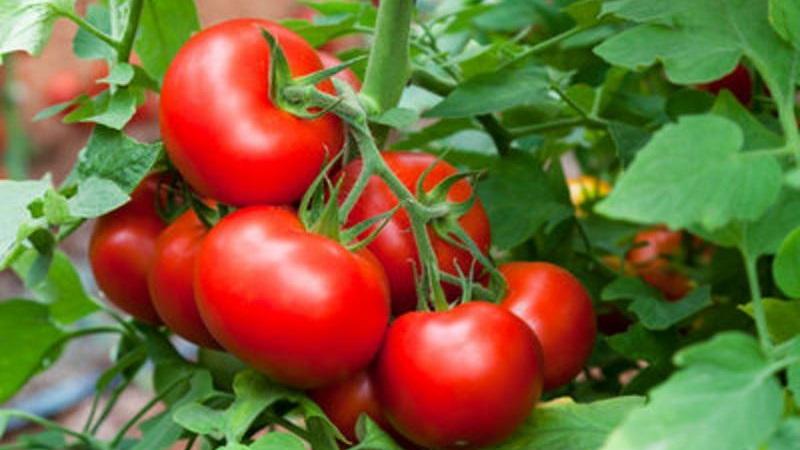
Conclusion
The description of the variety, photos, reviews of the tomato Dubrava included in the review of the article told about the time-tested tomato culture, known since the times of the USSR. The fact that this variety of tomatoes has survived to this day and is in great demand and respect among experienced gardeners indicates its indispensability in any summer cottage in any weather and in any region.
Not every vegetable crop is able to step over from one era to another without losing its relevance, still occupying pride of place in summer cottages.